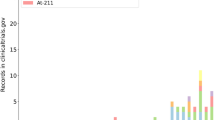Abstract
Many technical advances in CT have reduced radiation exposure in children and adults. These advances in technology should be used in conjunction with CT techniques such as appropriate patient preparation and intravenous contrast media administration to maximize dose management and image quality. This article summarizes current dose reduction technologies for pediatric CT, noting ranges of dose reduction as well as potential limitations. Discussion includes some of the elusive aspects of assessing image quality and the need for developing personalized CT.




Similar content being viewed by others
References
Slovis TL, Frush DP, Goske MJ (2013) An amazing accomplishment — CT manufacturers deserve our thanks. Pediatr Radiol 43:132–134
Goske MJ, Strauss KJ, Coombs LP et al (2013) Diagnostic reference ranges for pediatric abdominal CT. Radiology 268:208–218
Kalra MK, Maher MM, Toth TL et al (2004) Techniques and applications of automatic tube current modulation for CT. Radiology 233:649–657
Greess H, Nomayr A, Wolf H et al (2002) Dose reduction in CT examination of children by an attenuation-based on-line modulation of tube current (CARE dose). Eur Radiol 12:1571–1576
Kojima M, Itoh S, Ikeda M et al (2003) Usefulness of a method for changing tube current during helical scanning in multislice CT. Radiat Med 21:193–204
Grees H, Iutz J, Nomayr A et al (2003) Dose reduction in subsecond multislice spiral CT examination of children by online tube current modulation. Eur Radiol 14:995–999
Peng Y, Li J, Ma D et al (2009) Use of automatic tube current modulation with a standardized noise index in young children undergoing chest computed tomography scans with 64-slice multidetector computed tomography. Acta Radiol 50:1175–1181
Frush DP (2008) MDCT in children: scan techniques and contrast issues. In: Kalra MK, Saini S, Rubin GD (eds) MDCT: from protocols to practice. Springer-Verlag Italia, Milan, pp 333–354
Deak PD, Langner O, Lell M et al (2009) Effects of adaptive section collimation on patient radiation dose in multisection spiral CT. Radiology 252:140–147
Goetti R, Winklehner A, Gordic S et al (2012) Automated attenuation-based kilovoltage selection: preliminary observations in patients after endovascular aneurysm repair of the abdominal aorta. AJR Am J Roentgenol 199:W380–W385
Schindera ST, Winklehner A, Alkadhi H et al (2013) Effect of automatic tube voltage selection on image quality and radiation dose in abdominal CT angiography of various body sizes: a phantom study. Clin Radiol 68:e79–e86
Siegel MJ, Hildebolt C, Bradley D (2013) Effects of automated kilovoltage selection technology on contrast-enhanced pediatric CT and CT angiography. Radiology 268:538–547
Siegel MJ, Ramirez-Giraldo JC, Hildebolt C et al (2013) Automated low-kilovoltage selection in pediatric computed tomography angiography. Phantom study evaluating effects on radiation dose and image quality. Invest Radiol 48:1–6
Brinkley MF, Ramirez-Giraldo JC, Samei E et al (2014) Effects of automatic tube potential selection on radiation dose, image quality and lesion detectability in pediatric abdominopelvic CT and CTA: a phantom study. Pediatr Radiol 44:S88
Lungren MP, Yoshizumi TT, Brady SM et al (2012) Radiation dose estimations to the thorax using organ-based dose modulation. AJR Am J Roentgenol 199:W65–W73
Kim S, Frush DP, Yoshizumi TT (2010) Bismuth shielding in CT: support for use in children. Pediatr Radiol 40:1739–1743
Wang J, Duan X, Christner JA et al (2011) Radiation dose reduction to the breast in thoracic CT: comparison of bismuth shielding, organ-based tube current modulation, and use of a globally decreased tube current. Med Phys 38:6084–6092
Lerner C, Frush DP, Boll DT (2008) Evaluation of a coronary-cameral fistula: benefits of coronary dual-source MDCT angiography in children. Pediatr Radiol 38:874–878
Johnston JH, Podberesky DJ, Yoshizumi TT et al (2013) Comparison of radiation dose estimates, image noise, and scan duration in pediatric body imaging using 320-detector volume CT and 64-detector helical MDCT. Pediatr Radiol 43:1117–1127
Podberesky D, Angel E, Yoshizumi TT et al (2013) Comparison of radiation dose estimates and scan performance in pediatric high-resolution thoracic CT for volumetric 320-detector row, helical 64-detector row, and non-contiguous axial scan acquisitions. Acad Radiol 20:1152–1161
Podberesky D, Angel E, Yoshizumi TT et al (2012) Radiation dose estimation for prospective and retrospective ECG-gated cardiac CT angiography in infants and small children using a 320-MDCT volume scanner. AJR Am J Roentgenol 199:1129–1135
Singh S, Kalra MK, Shenoy-Bhangle AS et al (2012) Radiation dose reduction with hybrid iterative reconstruction for pediatric CT. Radiology 263:537–546
Brady SL, Moore BM, Yee BS et al (2014) Pediatric CT: implementation of ASIR for substantial radiation dose reduction while maintaining pre-ASIR image noise. Radiology 270:223–231
Smith EA, Dillman JR, Goodsitt MM et al (2014) Model-based iterative reconstruction: effect on patient radiation dose and image quality in pediatric body CT. Radiology 270:526–534
Katsura M, Matsuda I, Akahane M et al (2012) Model-based iterative reconstruction technique for radiation dose reduction in chest CT: comparison with the adaptive statistical iterative reconstruction technique. Eur Radiol 22:1613–1623
Heye T, Nelson RC, Ho LM et al (2012) Dual-energy CT applications in the abdomen. AJR Am J Roentgenol 199:S64–S70
National Electrical Manufacturers Association (2010) NEMA Standards Publication XR 25–2010: computed tomography dose check. http://www.nema.org/standards/pages/computed-tomography-dose-check.aspx?#download. Accessed 2 Feb 2014
Xiaoyu Tian X, Li X, Segars WP et al (2014) Pediatric chest and abdominopelvic CT: organ dose estimation based on 42 patient models. Radiology 270:535–547
Conflicts of interest
Dr. Frush has no financial interests, investigational or off-label uses to disclose.
Author information
Authors and Affiliations
Corresponding author
Rights and permissions
About this article
Cite this article
Frush, D.P. Overview of CT technologies for children. Pediatr Radiol 44 (Suppl 3), 422–426 (2014). https://doi.org/10.1007/s00247-014-3043-8
Received:
Revised:
Accepted:
Published:
Issue Date:
DOI: https://doi.org/10.1007/s00247-014-3043-8




